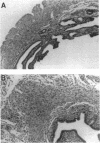Abstract
Following intravaginal inoculation of progesterone-treated outbred mice with Chlamydia trachomatis MoPn, 4 to 6 log10 inclusion-forming units were recovered in vaginal swabs for 21 days but all animals were culture negative after 28 days. Serum antibody titers were elevated and remained high for at least 70 days. Between 28 and 70 days, upper tract infection (inflammation and distension of the uterine horns, occlusion of oviducts with inflammatory exudate, pyosalpinx, and hydrosalpinx) was seen in > 80% of the animals. Mice were dosed orally, commencing at 7 days after infection, with minocycline, doxycycline, or amoxicillin-clavulanate. Further groups received azithromycin either as a single high dose or as lower once-daily doses. In addition, minocycline and amoxicillin-clavulanate were administered at 24 h after infection, and this early treatment prevented elevation of antibody titers whereas delayed therapy did not. Vaginal swabs from mice in all treatment regimens were culture negative except for 25% of mice receiving either early amoxicillin-clavulanate or low-dose azithromycin, which yielded low numbers (20 to 70 inclusion-forming units) of chlamydiae. Numbers of fertile mice in the early treatment regimens and their litter sizes were similar to those of noninfected controls, although 25% of amoxicillin-clavulanate-treated mice had unilateral hydrosalpinges. In comparison, 88% of untreated mice developed hydrosalpinges and only 25% conceived. Delayed dosing did not affect the outcome of amoxicillin-clavulanate therapy but did diminish the protective efficacy of minocycline such that 50% of treated mice had either unilateral hydrosalpinges or ovarian abscesses. Doxycycline and azithromycin were highly effective in restoring fertility. This model makes possible the study of both short- and long-term outcomes of chlamydial infection.
Full text
PDF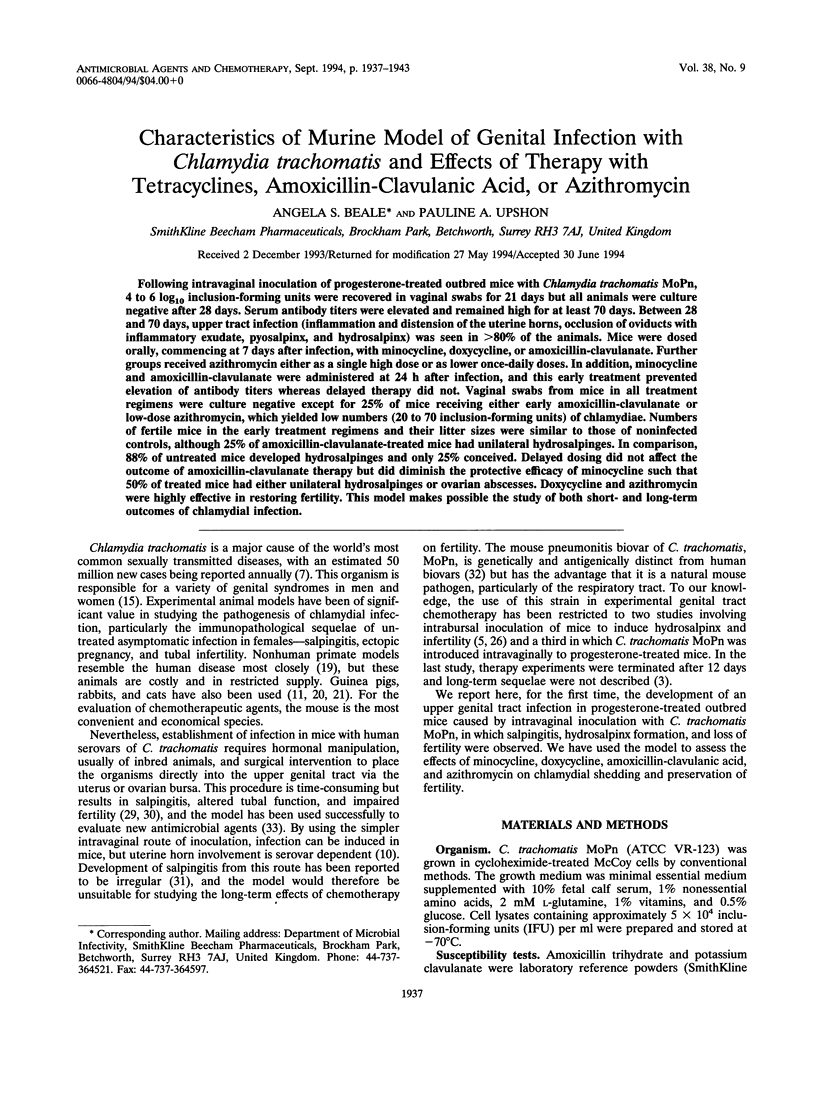
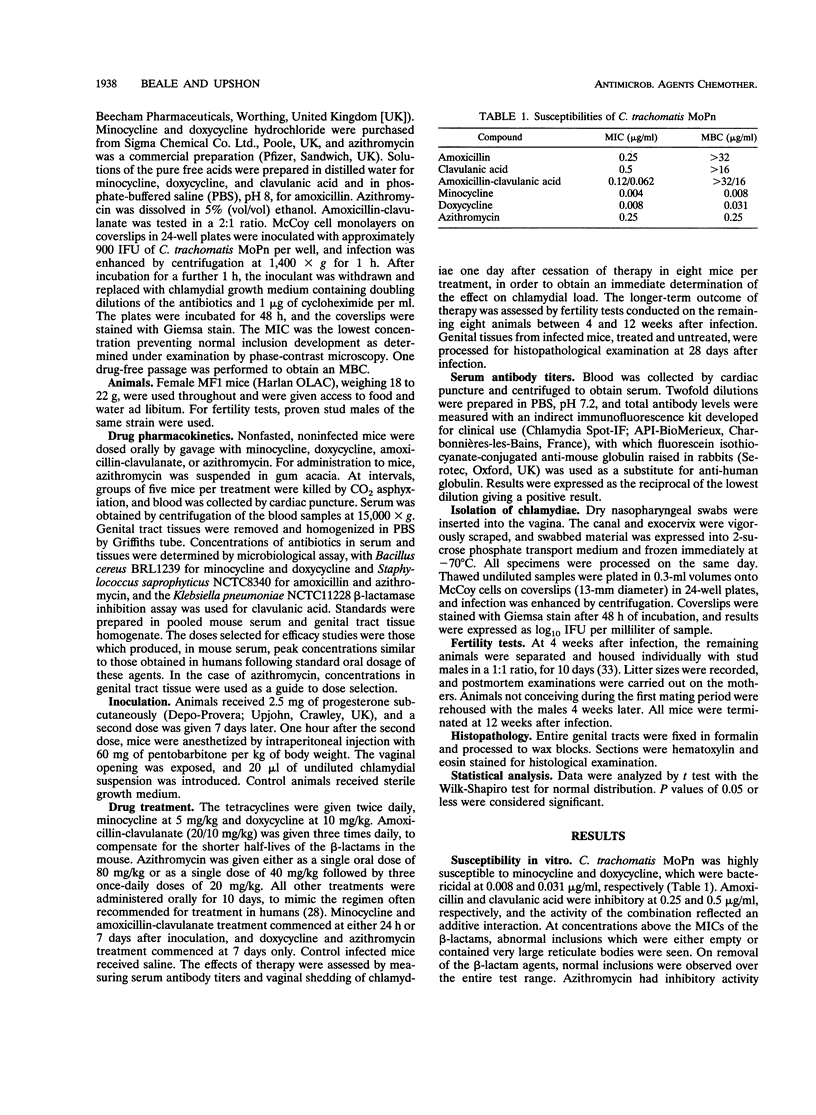
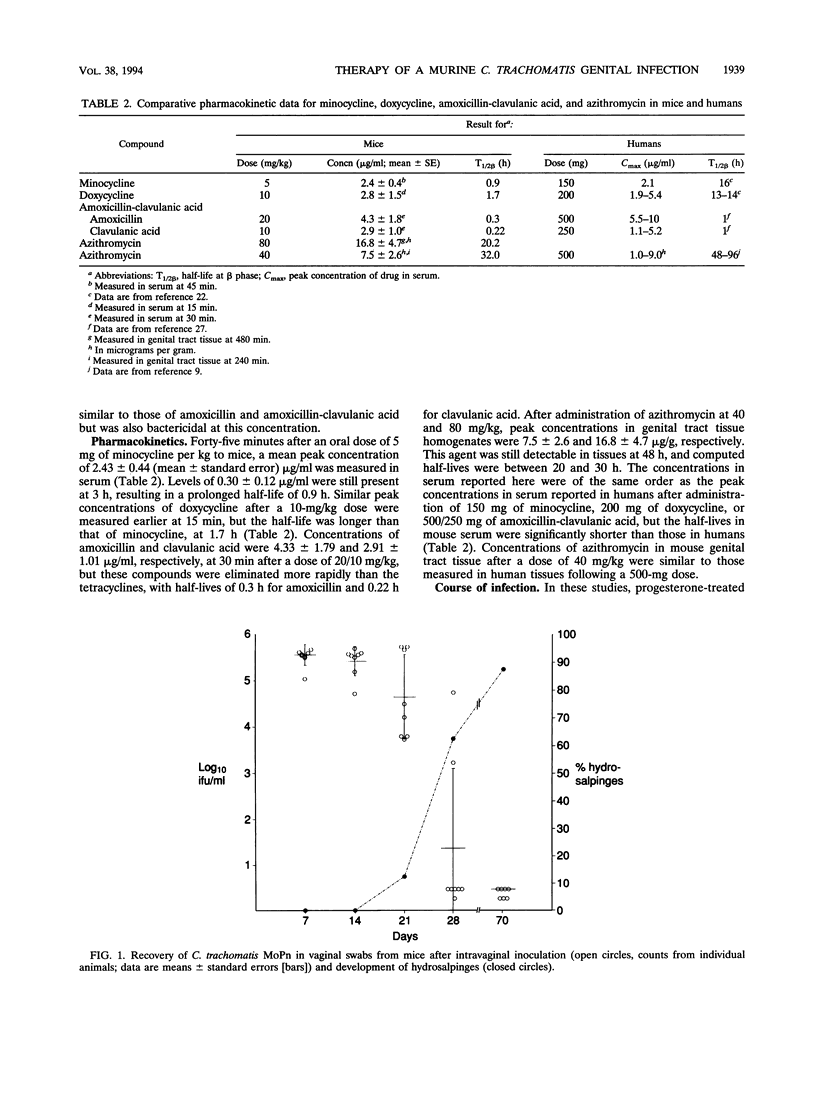
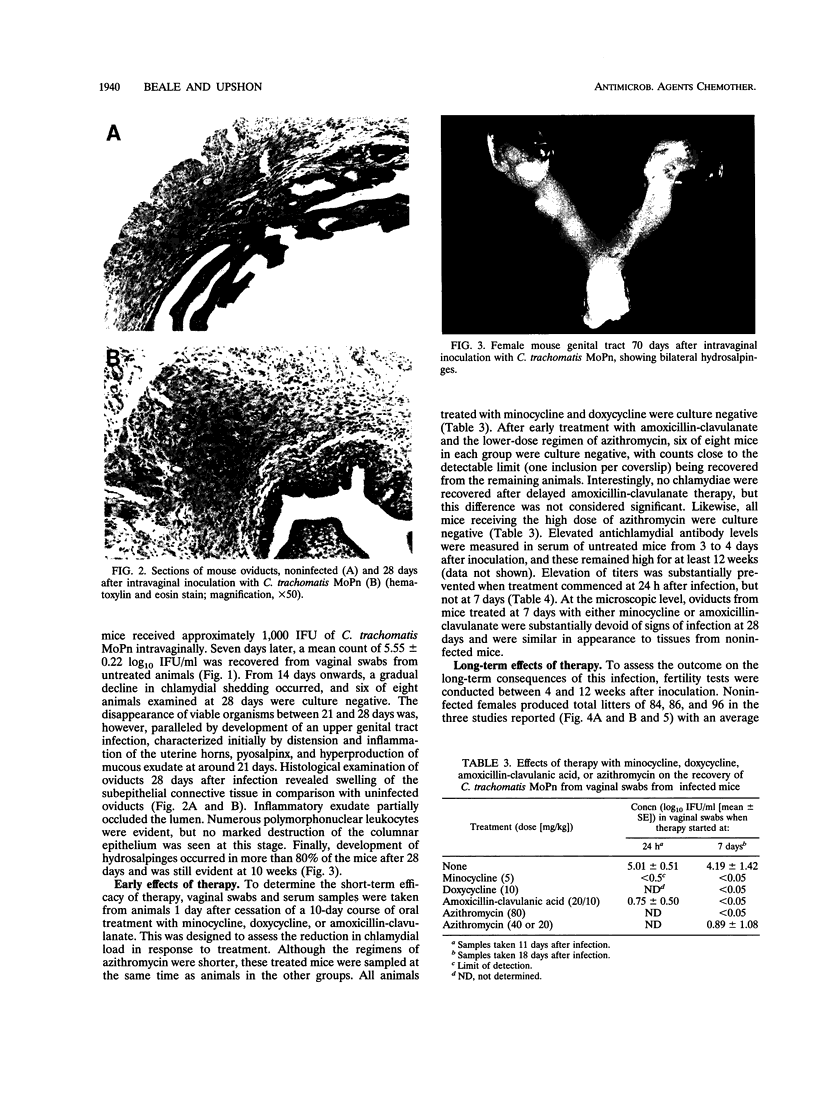
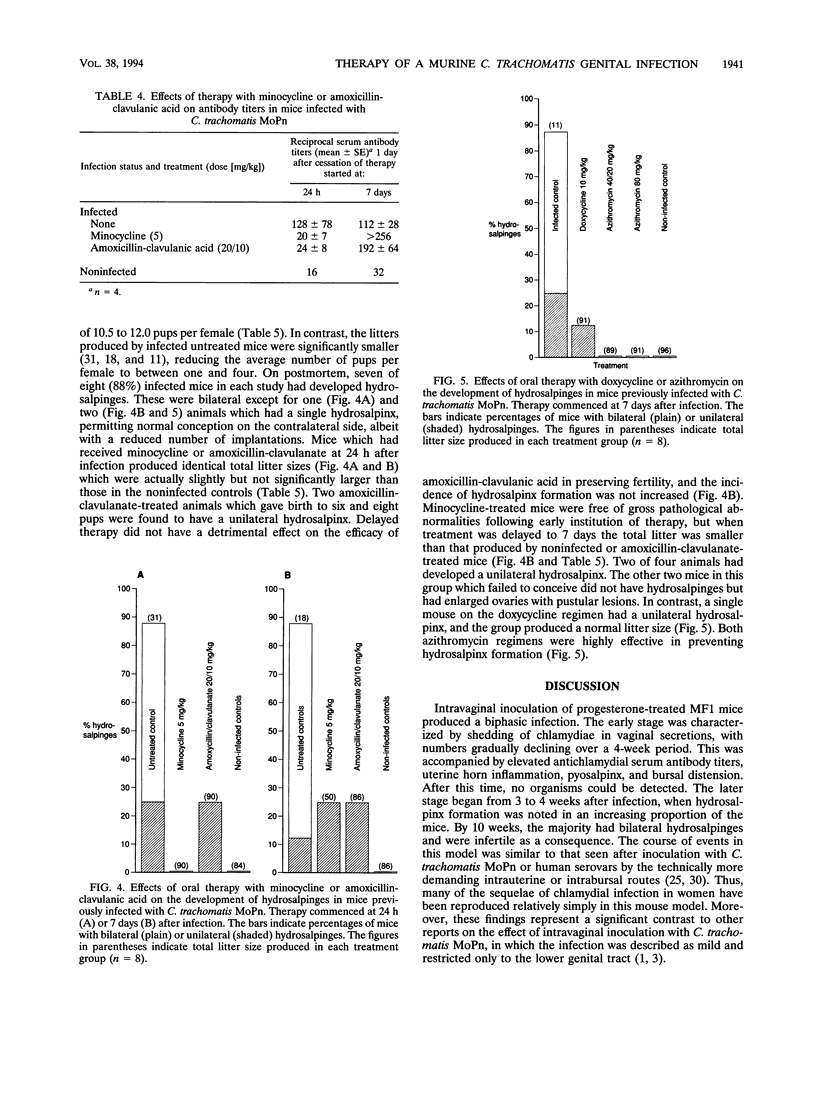
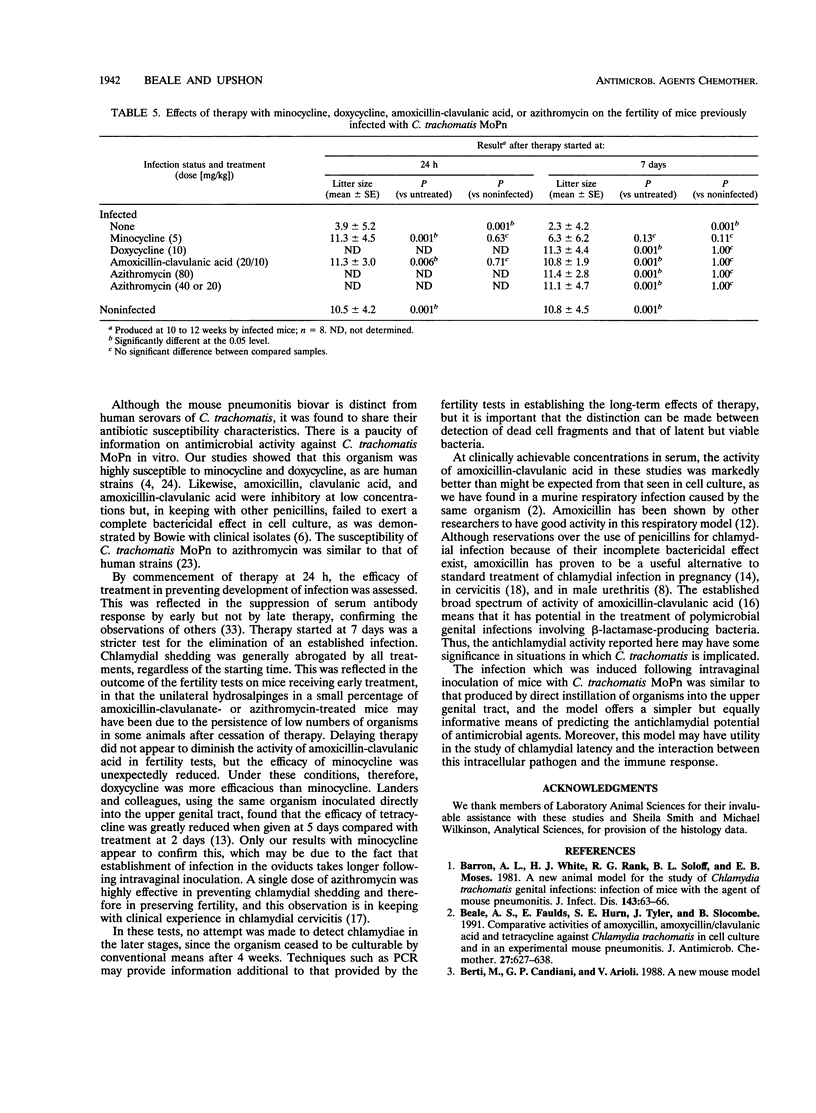
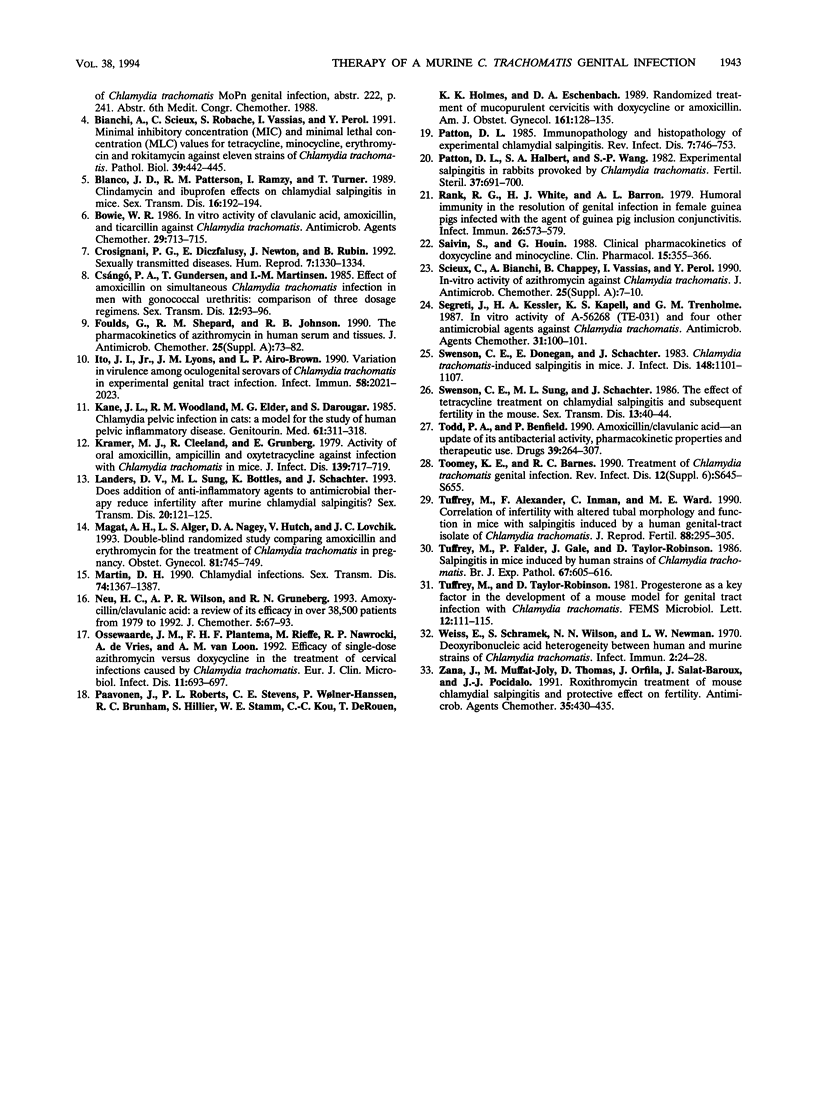
Images in this article
Selected References
These references are in PubMed. This may not be the complete list of references from this article.
- Barron A. L., White H. J., Rank R. G., Soloff B. L., Moses E. B. A new animal model for the study of Chlamydia trachomatis genital infections: infection of mice with the agent of mouse pneumonitis. J Infect Dis. 1981 Jan;143(1):63–66. doi: 10.1093/infdis/143.1.63. [DOI] [PubMed] [Google Scholar]
- Beale A. S., Faulds E., Hurn S. E., Tyler J., Slocombe B. Comparative activities of amoxycillin, amoxycillin/clavulanic acid and tetracycline against Chlamydia trachomatis in cell culture and in an experimental mouse pneumonitis. J Antimicrob Chemother. 1991 May;27(5):627–638. doi: 10.1093/jac/27.5.627. [DOI] [PubMed] [Google Scholar]
- Bianchi A., Scieux C., Robache S., Vassias I., Pérol Y. Etude comparative des concentrations minimales inhibitrices (CMI) et des concentrations minimales léthales (CML) de la tétracycline, de la minocycline, de l'érythromycine et de la rokitamycine sur onze souches de Chlamydia trachomatis. Pathol Biol (Paris) 1991 May;39(5):442–445. [PubMed] [Google Scholar]
- Blanco J. D., Patterson R. M., Ramzy I., Turner T. Clindamycin and ibuprofen effects on chlamydial salpingitis in mice. Sex Transm Dis. 1989 Oct-Dec;16(4):192–194. doi: 10.1097/00007435-198910000-00007. [DOI] [PubMed] [Google Scholar]
- Bowie W. R. In vitro activity of clavulanic acid, amoxicillin, and ticarcillin against Chlamydia trachomatis. Antimicrob Agents Chemother. 1986 Apr;29(4):713–715. doi: 10.1128/aac.29.4.713. [DOI] [PMC free article] [PubMed] [Google Scholar]
- Crosignani P. G., Diczfalusy E., Newton J., Rubin B. Sexually transmitted diseases. Hum Reprod. 1992 Oct;7(9):1330–1334. doi: 10.1093/oxfordjournals.humrep.a137851. [DOI] [PubMed] [Google Scholar]
- Csángó P. A., Gundersen T., Martinsen I. M. Effect of amoxicillin on simultaneous Chlamydia trachomatis infection in men with gonococcal urethritis: comparison of three dosage regimens. Sex Transm Dis. 1985 Apr-Jun;12(2):93–96. doi: 10.1097/00007435-198504000-00009. [DOI] [PubMed] [Google Scholar]
- Foulds G., Shepard R. M., Johnson R. B. The pharmacokinetics of azithromycin in human serum and tissues. J Antimicrob Chemother. 1990 Jan;25 (Suppl A):73–82. doi: 10.1093/jac/25.suppl_a.73. [DOI] [PubMed] [Google Scholar]
- Ito J. I., Jr, Lyons J. M., Airo-Brown L. P. Variation in virulence among oculogenital serovars of Chlamydia trachomatis in experimental genital tract infection. Infect Immun. 1990 Jun;58(6):2021–2023. doi: 10.1128/iai.58.6.2021-2023.1990. [DOI] [PMC free article] [PubMed] [Google Scholar]
- Kane J. L., Woodland R. M., Elder M. G., Darougar S. Chlamydial pelvic infection in cats: a model for the study of human pelvic inflammatory disease. Genitourin Med. 1985 Oct;61(5):311–318. doi: 10.1136/sti.61.5.311. [DOI] [PMC free article] [PubMed] [Google Scholar]
- Kramer M. J., Cleeland R., Grunberg E. Activity of oral amoxicillin, ampicillin, and oxytetracycline against infection with chlamydia trachomatis in mice. J Infect Dis. 1979 Jun;139(6):717–719. doi: 10.1093/infdis/139.6.717. [DOI] [PubMed] [Google Scholar]
- Landers D. V., Sung M. L., Bottles K., Schachter J. Does addition of anti-inflammatory agents to antimicrobial therapy reduce infertility after murine chlamydial salpingitis? Sex Transm Dis. 1993 May-Jun;20(3):121–125. doi: 10.1097/00007435-199305000-00001. [DOI] [PubMed] [Google Scholar]
- Magat A. H., Alger L. S., Nagey D. A., Hatch V., Lovchik J. C. Double-blind randomized study comparing amoxicillin and erythromycin for the treatment of Chlamydia trachomatis in pregnancy. Obstet Gynecol. 1993 May;81(5 ):745–749. [PubMed] [Google Scholar]
- Martin D. H. Chlamydial infections. Med Clin North Am. 1990 Nov;74(6):1367–1387. doi: 10.1016/s0025-7125(16)30486-2. [DOI] [PubMed] [Google Scholar]
- Neu H. C., Wilson A. P., Grüneberg R. N. Amoxycillin/clavulanic acid: a review of its efficacy in over 38,500 patients from 1979 to 1992. J Chemother. 1993 Apr;5(2):67–93. doi: 10.1080/1120009x.1993.11739213. [DOI] [PubMed] [Google Scholar]
- Ossewaarde J. M., Plantema F. H., Rieffe M., Nawrocki R. P., de Vries A., van Loon A. M. Efficacy of single-dose azithromycin versus doxycycline in the treatment of cervical infections caused by Chlamydia trachomatis. Eur J Clin Microbiol Infect Dis. 1992 Aug;11(8):693–697. doi: 10.1007/BF01989972. [DOI] [PubMed] [Google Scholar]
- Paavonen J., Roberts P. L., Stevens C. E., Wølner-Hanssen P., Brunham R. C., Hillier S., Stamm W. E., Kuo C. C., DeRouen T., Holmes K. K. Randomized treatment of mucopurulent cervicitis with doxycycline or amoxicillin. Am J Obstet Gynecol. 1989 Jul;161(1):128–135. doi: 10.1016/0002-9378(89)90249-4. [DOI] [PubMed] [Google Scholar]
- Patton D. L., Halbert S. A., Wang S. P. Experimental salpingitis in rabbits provoked by Chlamydia trachomatis. Fertil Steril. 1982 May;37(5):691–700. [PubMed] [Google Scholar]
- Patton D. L. Immunopathology and histopathology of experimental chlamydial salpingitis. Rev Infect Dis. 1985 Nov-Dec;7(6):746–753. doi: 10.1093/clinids/7.6.746. [DOI] [PubMed] [Google Scholar]
- Rank R. G., White H. J., Barron A. L. Humoral immunity in the resolution of genital infection in female guinea pigs infected with the agent of guinea pig inclusion conjunctivitis. Infect Immun. 1979 Nov;26(2):573–579. doi: 10.1128/iai.26.2.573-579.1979. [DOI] [PMC free article] [PubMed] [Google Scholar]
- Saivin S., Houin G. Clinical pharmacokinetics of doxycycline and minocycline. Clin Pharmacokinet. 1988 Dec;15(6):355–366. doi: 10.2165/00003088-198815060-00001. [DOI] [PubMed] [Google Scholar]
- Scieux C., Bianchi A., Chappey B., Vassias I., Pérol Y. In-vitro activity of azithromycin against Chlamydia trachomatis. J Antimicrob Chemother. 1990 Jan;25 (Suppl A):7–10. doi: 10.1093/jac/25.suppl_a.7. [DOI] [PubMed] [Google Scholar]
- Segreti J., Kessler H. A., Kapell K. S., Trenholme G. M. In vitro activity of A-56268 (TE-031) and four other antimicrobial agents against Chlamydia trachomatis. Antimicrob Agents Chemother. 1987 Jan;31(1):100–101. doi: 10.1128/aac.31.1.100. [DOI] [PMC free article] [PubMed] [Google Scholar]
- Swenson C. E., Donegan E., Schachter J. Chlamydia trachomatis-induced salpingitis in mice. J Infect Dis. 1983 Dec;148(6):1101–1107. doi: 10.1093/infdis/148.6.1101. [DOI] [PubMed] [Google Scholar]
- Swenson C. E., Sung M. L., Schachter J. The effect of tetracycline treatment on chlamydial salpingitis and subsequent fertility in the mouse. Sex Transm Dis. 1986 Jan-Mar;13(1):40–44. doi: 10.1097/00007435-198601000-00008. [DOI] [PubMed] [Google Scholar]
- Todd P. A., Benfield P. Amoxicillin/clavulanic acid. An update of its antibacterial activity, pharmacokinetic properties and therapeutic use. Drugs. 1990 Feb;39(2):264–307. doi: 10.2165/00003495-199039020-00008. [DOI] [PubMed] [Google Scholar]
- Toomey K. E., Barnes R. C. Treatment of Chlamydia trachomatis genital infection. Rev Infect Dis. 1990 Jul-Aug;12 (Suppl 6):S645–S655. doi: 10.1093/clinids/12.supplement_6.s645. [DOI] [PubMed] [Google Scholar]
- Tuffrey M., Alexander F., Inman C., Ward M. E. Correlation of infertility with altered tubal morphology and function in mice with salpingitis induced by a human genital-tract isolate of Chlamydia trachomatis. J Reprod Fertil. 1990 Jan;88(1):295–305. doi: 10.1530/jrf.0.0880295. [DOI] [PubMed] [Google Scholar]
- Tuffrey M., Falder P., Gale J., Taylor-Robinson D. Salpingitis in mice induced by human strains of Chlamydia trachomatis. Br J Exp Pathol. 1986 Aug;67(4):605–616. [PMC free article] [PubMed] [Google Scholar]
- Weiss E., Schramek S., Wilson N. N., Newman L. W. Deoxyribonucleic Acid Heterogeneity Between Human and Murine Strains of Chlamydia trachomatis. Infect Immun. 1970 Jul;2(1):24–28. doi: 10.1128/iai.2.1.24-28.1970. [DOI] [PMC free article] [PubMed] [Google Scholar]
- Zana J., Muffat-Joly M., Thomas D., Orfila J., Salat-Baroux J., Pocidalo J. J. Roxithromycin treatment of mouse chlamydial salpingitis and protective effect on fertility. Antimicrob Agents Chemother. 1991 Mar;35(3):430–435. doi: 10.1128/aac.35.3.430. [DOI] [PMC free article] [PubMed] [Google Scholar]




